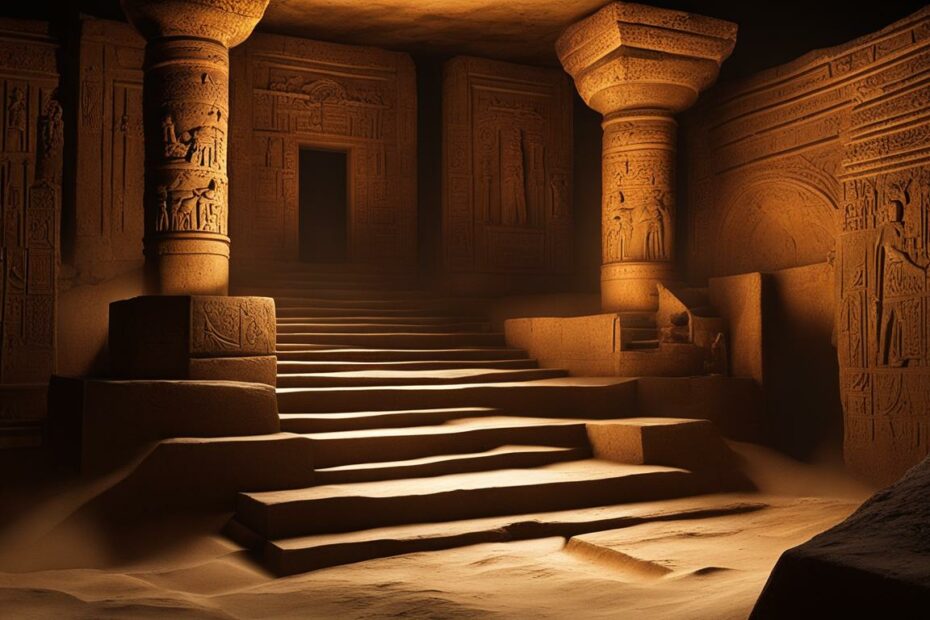Welcome to a fascinating journey through the tomb of ancient Egypt. Delve into the mysteries and allure of ancient Egyptian burial sites as we uncover the secrets of their funerary practices. In this comprehensive guide, we will explore the rituals and ceremonies that surrounded death in ancient Egypt, the beliefs about the soul and the afterlife, the process of mummification, the purpose and symbolism of tombs, and much more.
Prepare to be captivated by the wonders of ancient Egyptian tombs, where art, spirituality, and the pursuit of eternal life converge. Let us delve into the enigmatic world of ancient Egypt, where the past comes alive.
Unlocking the Mysteries of Death in Ancient Egypt
In ancient Egypt, death was believed to be a profound transition to the afterlife, a journey filled with mystery and significance. The ancient Egyptians held strong beliefs about death and the afterlife, which shaped their funerary practices and rituals. Understanding these beliefs is essential in deciphering the purpose and symbolism behind the tombs that have captivated archaeologists and historians for centuries.
According to ancient Egyptian views on the afterlife, death was not seen as the end, but rather as a gateway to a new existence. They believed that the soul, often referred to as the “ba,” continued on after death, while the body, known as the “ka,” required preservation through mummification to ensure a successful journey in the afterlife.
Ancient Egyptians embraced death rituals and ceremonies as a means to guide the deceased on their passage to the afterlife. These rites included the Opening of the Mouth ritual, which aimed to awaken the senses of the deceased, enabling them to partake in the joys and pleasures of the beyond. Through these rituals, the ancient Egyptians believed they could ensure the deceased’s eternal unity with the gods.
By unraveling the mysteries of death in ancient Egypt, we gain a deeper understanding of the profound beliefs and intricate rituals that shaped their society. Through their views on death and the afterlife, the ancient Egyptians aimed to achieve immortality and eternal bliss in the realm of the gods.
The Enigmatic Soul of Ancient Egyptians
In ancient Egyptian culture, the concept of the soul held profound significance in their beliefs about the afterlife. The ancient Egyptians believed in a dual nature of the soul, consisting of the ka and ba. The ka was considered the animating life force, while the ba represented the individual essence of a person.
Understanding the Ka and Ba
The ka, often depicted as a person’s double, was believed to reside within the body and maintain the individual’s life force. It was considered essential for the person’s existence both in life and in the afterlife. The ancient Egyptians believed that the ka needed to be preserved and sustained, as its departure could result in death.
On the other hand, the ba was considered the spiritual aspect of the soul. It was believed to have the ability to move freely and independently, even after death. The ba was thought to wander the earth, maintaining connections with the living and visiting its earthly possessions.
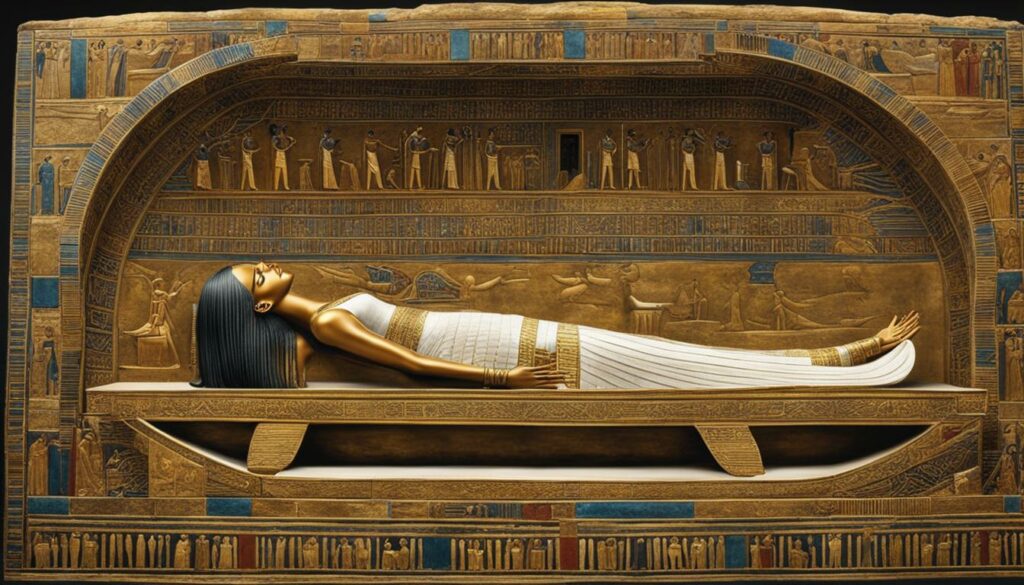
The Role of the Akh in Achieving Eternity
In addition to the ka and ba, ancient Egyptians believed in the existence of the akh. The akh was a transfigured form of the soul that had the potential to achieve eternal unity with the realm of the gods. It was believed that the akh could influence events on earth even after death.
The ancient Egyptians believed that to achieve eternal life and join the gods in the afterlife, one’s ka and ba needed to merge and transform into the akh. This process was seen as a journey of purification and spiritual transformation, guided by rituals and funerary practices.
The understanding of the soul and its components was vital in shaping ancient Egyptian funerary practices. It influenced the mummification process, tomb art, and the inclusion of various offerings and rituals to assist in the journey of the soul.
To learn more about the intriguing world of ancient Egyptian funerary practices, continue reading the next sections of this guide.
Ancient Egyptian Funerary Rites and Ceremonies
In ancient Egypt, funerary rites and ceremonies played a crucial role in ensuring a successful transition to the afterlife. These rituals were deeply ingrained in ancient Egyptian funeral traditions and were believed to facilitate the deceased’s journey to the realm of the gods. Two significant ceremonies that were integral to these traditions were the Procession to the Nile and the Opening of the Mouth ritual.
The Procession to the Nile
The Procession to the Nile was a pivotal part of ancient Egyptian burial rituals. It involved transporting the deceased’s body from the east bank of the Nile to the west bank, which symbolized death and completion. The Nile River held great importance in ancient Egyptian culture, representing a mystical pathway to the afterlife. The procession was accompanied by mourners who wailed and mourned, displaying their grief for the deceased. The journey to the west bank of the Nile was seen as a necessary step in the transition to the afterlife.
The Opening of the Mouth Ritual
The Opening of the Mouth ritual was another significant ceremony in ancient Egyptian funerary practices. This ritual aimed to restore consciousness and enable the deceased to continue their journey in the afterlife. The process involved a priest using various symbolic gestures and tools to open the deceased’s mouth, allowing them to eat, drink, and breathe in the realm of the gods. It was believed that without the successful completion of this ritual, the deceased would be unable to fully participate in the afterlife and receive the necessary sustenance.
These funerary rites and ceremonies highlight the deep-rooted beliefs and rituals surrounding death in ancient Egyptian culture. They served as crucial steps in ensuring a successful transition to the afterlife and were considered vital for the deceased’s eternal well-being.
The Art and Science of Mummification
In ancient Egypt, the mummification process was a remarkable fusion of art and science. The ancient Egyptians believed that the preservation of the body was crucial for the soul’s journey in the afterlife. Through meticulous embalming techniques and scientific knowledge, they developed a complex process to mummify the deceased.
The mummification process began with the removal of the brain through the nostrils using special hooks. This delicate procedure ensured that the body remained intact. Next, the internal organs were meticulously removed, except for the heart, which was believed to be the seat of intelligence and emotion.
The removed organs were then preserved in special containers called canopic jars. Each jar represented one of the four sons of Horus and was protected by a specific deity. These jars played a vital role in ensuring the deceased’s bodily integrity and perfect preservation.
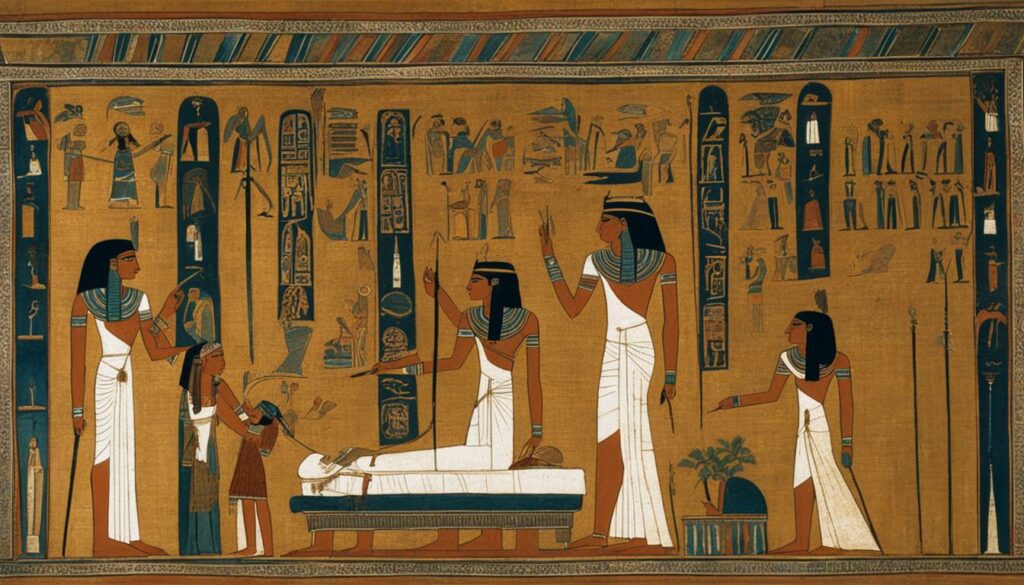
Once the organs were removed, the body was thoroughly washed and then packed with natron, a naturally occurring salt mixture, to facilitate drying. Natron helped remove moisture from the body and prevent decay. The body was then left to desiccate for approximately 40 days, after which it was carefully wrapped in linen bandages.
The wrapping of the body was a painstaking process, with each layer of linen carefully applied and secured with resin. The layers of bandages often included amulets and charms to provide protection in the afterlife.
This meticulous mummification process ensured the preservation of the body, allowing the deceased to embark on their journey in the afterlife. It was a testament to the ancient Egyptians’ belief in the continuity of life beyond death and their dedication to honoring the deceased.
| Step | Description |
|---|---|
| 1 | Brain removal through the nostrils using special hooks. |
| 2 | Removal of internal organs, except for the heart. |
| 3 | Preservation of organs in canopic jars. |
| 4 | Packing of the body with natron to facilitate drying. |
| 5 | Desiccation of the body for approximately 40 days. |
| 6 | Wrapping the body in linen bandages and securing with resin. |
The Tomb of Ancient Egypt: A Vestibule to the Afterlife
In ancient Egypt, tombs held great significance as they were believed to serve as gateways to the afterlife. These sacred structures were considered the final resting place for the deceased, providing a place of eternal peace and tranquility.
The architectural features of tombs played a crucial role in facilitating the journey of the soul beyond death. The burial chamber within the tomb served as a sanctuary, where the body would be placed alongside funerary offerings and possessions to accompany the deceased in the afterlife.
One important component of ancient Egyptian tombs was the vestibule, a transitional space leading from the outside world into the burial chamber. The vestibule represented a threshold between the earthly realm and the realms of the gods. It was here that rituals and ceremonies were performed to ensure the purification and protection of the deceased.
The symbolism embedded in tomb structures added further depth to their purpose. The design and layout of tombs often reflected the beliefs and cosmology of ancient Egyptian culture. For example, the arrangement of chambers and corridors within a tomb could represent the journey of the soul through the underworld, guided by various deities and encountering challenges along the way.
The decoration and artwork found within tombs also carried symbolic meaning. Murals and carvings depicted scenes from the deceased’s life, as well as religious and mythological imagery associated with the afterlife. These visual representations served as a form of communication between the living and the deceased, helping to ensure the continuity of the deceased’s existence in the afterlife.
By understanding the purpose and symbolism of ancient Egyptian tombs, we gain valuable insights into the beliefs and practices surrounding death and the afterlife in this fascinating civilization.
Preserving Life Beyond Death: Canopic Jars and Their Significance
Canopic jars held a crucial role in ancient Egyptian burial practices, ensuring the preservation of the deceased in the afterlife. These beautifully crafted containers were specifically designed to protect and store the organs of the departed. Through the intricate process of mummification, the internal organs were removed from the body to prevent decay, and then carefully placed into canopic jars.
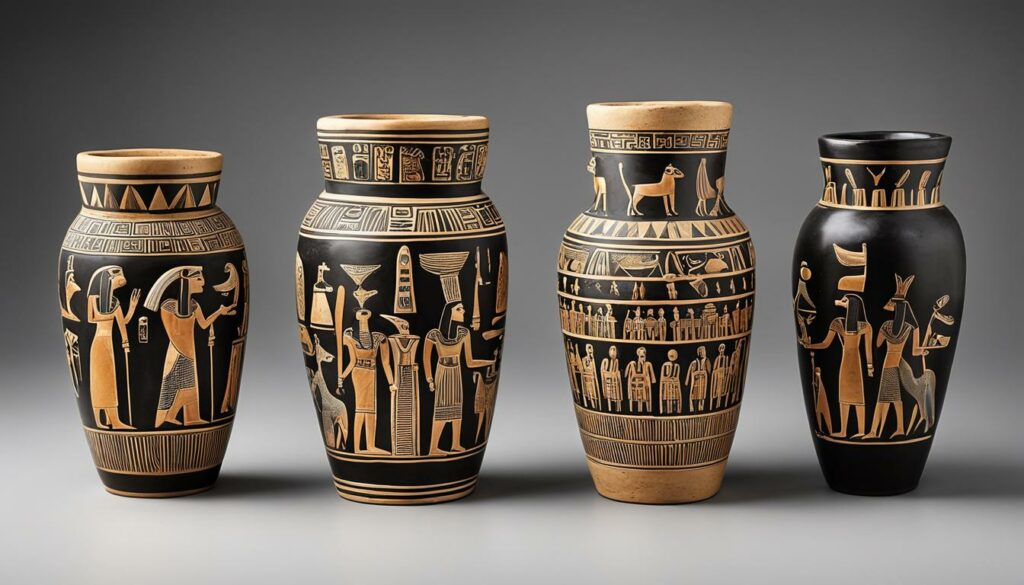
Hapi, Duamutef, Qebsennuf, and Amset: Guardians of the Organs
| Canopic Jar | Guardian | Organ |
|---|---|---|
| Hapi | Baboon-headed | Lungs |
| Duamutef | Jackal-headed | Stomach |
| Qebsennuf | Falcon-headed | Intestines |
| Amset | Human-headed | Liver |
The four sons of Horus, Hapi, Duamutef, Qebsennuf, and Amset, were the guardians of these canopic jars. Each son was associated with a specific organ and depicted with a unique animal head. Their presence symbolized the protection of the organs and ensured the completeness of the deceased in the afterlife.
These canopic jars were not only functional but also highly decorative. Elaborate carvings and intricate designs adorned the jars, depicting the symbols and gods associated with the organs they contained. The canopic jars were placed in the tomb alongside the mummified body, providing a sense of security and preservation for the journey beyond death.
Coffins and Sarcophagi: Containers for Eternity
In ancient Egypt, coffins and sarcophagi played a crucial role in the burial practices and beliefs surrounding the afterlife. These burial containers were designed to protect and preserve the deceased as they embarked on their eternal journey.
The Evolution of Sarcophagus Design
Over the centuries, the design of sarcophagi in ancient Egypt evolved from simple rectangular boxes to intricate and ornate structures. Initially, sarcophagi were plain in appearance, made of wood or stone, and primarily served as functional containers for the body. However, as time passed, sarcophagi grew more elaborate, adorned with religious symbols and hieroglyphic inscriptions that conveyed the deceased’s status and spiritual journey.
Anthropoid Coffins and their Artistic Merit
One of the notable developments in coffin design was the introduction of anthropoid coffins, which were crafted to resemble the shape of a human body. These coffins were often painted and decorated with intricate designs, showcasing the artistic skill of ancient Egyptian craftsmen. The intricate decorations on anthropoid coffins served both practical and symbolic purposes, providing protection for the deceased and representing their passage into the afterlife.
| Sarcophagus Features | Description |
|---|---|
| Elaborate Carvings | Sarcophagi were adorned with elaborate carvings depicting religious scenes, deities, and the deceased’s journey in the afterlife. |
| Hieroglyphic Inscriptions | These inscriptions contained spells, prayers, and instructions to guide the deceased in the afterlife and ensure their spiritual well-being. |
| Symbolic Representations | Various symbols such as the winged scarab and the Eye of Horus were commonly depicted on sarcophagi, representing protection, rebirth, and resurrection. |
The artistic merit of ancient Egyptian coffins and sarcophagi not only served as a testament to the skill and craftsmanship of the time but also provided a visual representation of the beliefs and aspirations of the deceased. These burial containers acted as vessels, safeguarding the soul as it embarked on its eternal voyage through the afterlife.
In Summary
Coffins and sarcophagi held significant importance in ancient Egyptian burial practices. The evolution of sarcophagus design, from simple rectangular boxes to elaborate and symbolically rich structures, reflected the evolving beliefs and cultural understanding of the afterlife. Anthropoid coffins, designed in the shape of a human body, showcased the artistic prowess of ancient Egyptian craftsmen and provided a visual representation of the deceased’s spiritual journey. Through their intricate decorations and symbolism, these burial containers served as the final resting place for the deceased and facilitated their transition into the realm of eternity.
Navigating the Afterlife: Journeys of the Ba
In ancient Egypt, the concept of the afterlife held great significance. According to their beliefs, the soul, known as the ba, embarked on a spiritual journey after death. This journey was filled with challenges and trials as the ba made its way to meet the gods and achieve eternal unity.
Offerings and prayers played a crucial role in assisting the ba on its voyage. Ancient Egyptians believed that by providing these offerings, they could ensure the well-being of the ba and enable it to navigate the treacherous paths of the afterlife.
The ba’s journey in the afterlife was a spiritual quest, where it encountered obstacles and underwent judgment to determine its fate. Through rituals and offerings, the living aided the ba in overcoming these challenges and achieving a harmonious reunion with the gods.
This ancient Egyptian belief in the spiritual journey of the soul underscored the importance of funerary practices and the preservation of the deceased’s body. It reinforced the idea that death was not the end but a transition to a new existence, wherein the ba could achieve eternal unity with the divine.
| Stage | Description |
|---|---|
| 1 | The deceased’s ba leaves the body. |
| 2 | The ba encounters challenges and trials. |
| 3 | The ba undergoes judgment to determine its fate. |
| 4 | The ba reaches the realm of the gods and achieves eternal unity. |
This table summarizes the stages of the ancient Egyptian afterlife journey. From the moment the ba leaves the body to the final union with the gods, this spiritual quest was considered essential for achieving eternal life.
Decoding Tomb Art: Symbols and Icons in Burial Chambers
In ancient Egyptian burial chambers, the art and iconography serve a profound purpose, conveying powerful symbolic messages about the journey to the afterlife and the realms of the gods. These intricate and visually compelling decorations hold deep religious significance and provide insights into the beliefs and desires of the deceased in their eternal existence.
Religious Symbolism and Funerary Iconography
Ancient Egyptian tomb art is rich in religious symbols and motifs that reflect the complex belief system of the civilization. These symbols often depict deities, spiritual beings, and mythological creatures, representing the divine forces that governed the afterlife and the deceased’s journey beyond death.
One prominent symbol found in burial chambers is the Ankh, known as the “key of life.” It represents eternal life and is frequently held by gods or presented to the deceased as an offering. The image of the scarab beetle, associated with the sun god Ra, symbolizes rebirth and transformation, while the winged solar disk represents the journey of the soul into the celestial realm.
The iconic figure of the deceased, often depicted with crossed arms and holding agricultural tools, represents their earthly identity and occupation. Detailed and lifelike portraiture conveys the individual’s status and desires in the afterlife, emphasizing their connection to the earthly realm and their aspirations for eternity.
Other common symbols found in burial chambers include the lotus flower, representing rebirth; the Djed pillar, symbolizing stability and resurrection; and the Udjat or Eye of Horus, associated with protection and well-being.
Interpreting Common Scenes Found in Nobles’ Tombs
Among the scenes depicted in the tombs of nobles, certain recurring themes offer insights into the beliefs and activities of the ancient Egyptian elite. These scenes provide visual narratives of the deceased’s life, emphasizing their achievements, social status, and anticipated rewards in the afterlife.
Funerary banquets, often depicted in tombs, highlight the importance of communal feasting and celebration of life. These scenes illustrate the deceased’s desire for an abundant afterlife, where they can continue to enjoy lavish meals and social gatherings with family and friends.
Depictions of agricultural activities, such as sowing and harvesting, symbolize the deceased’s connection to the fertile land and their expectation of a bountiful and prosperous afterlife. Scenes of hunting and fishing reflect the nobles’ enjoyment of leisure activities and their desire to carry these pursuits into the eternal realm.
In scenes depicting religious ceremonies and rituals, the deceased is shown making offerings, performing prayers, or presenting themselves before the gods. These scenes communicate the individual’s piety and dedication to the gods, conveying their hope for divine favor and protection in the afterlife.
Overall, the tomb art found in nobles’ tombs provides a nuanced understanding of the religious beliefs, societal roles, and personal aspirations of the ancient Egyptian elite, offering a glimpse into their vision of immortality and their desire to be remembered and revered for eternity.
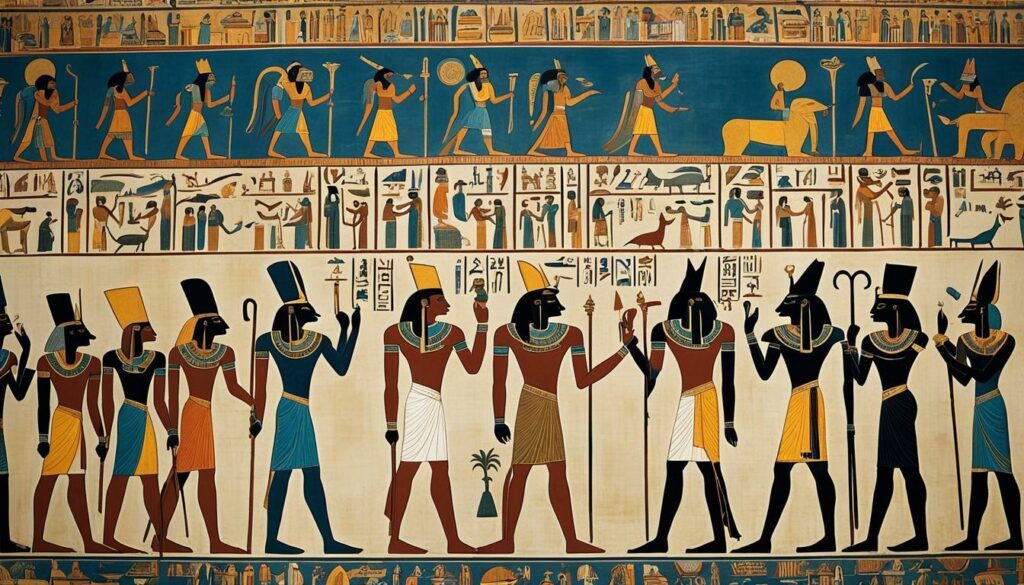
The Bridge between Worlds: Funerary Texts and Their Messages
The Book of the Dead: A Guidebook for the Deceased
In ancient Egyptian burial practices, funerary texts played a crucial role in guiding the deceased on their journey to the afterlife. Among these texts, the Book of the Dead stood out as a comprehensive guidebook, containing spells, prayers, and instructions that aimed to assist the deceased in navigating the treacherous path beyond death.
Depicted on papyrus scrolls buried alongside the deceased, the Book of the Dead served as a vital tool to ensure a successful transition into the afterlife. The texts within the Book of the Dead provided detailed directions on various aspects of the journey, including the dangers to avoid, the rituals to perform, and the judgment before the gods. By reciting the spells and carrying out the prescribed rituals, the deceased hoped to gain favor from the gods and secure a place in the eternal realm.
The Book of the Dead was not a single standardized text but rather a collection of spells and incantations that evolved over time. It was customized for each individual, with specific spells chosen based on their personal beliefs, status, and desires in the afterlife. The text was typically written in hieroglyphics or hieratic script and adorned with beautiful illustrations depicting the journey and the gods.
Through the Book of the Dead, the ancient Egyptians expressed their deep beliefs in the concepts of judgment, resurrection, and eternal life. It offered solace to the deceased and their loved ones, assuring them that death was not the end, but a transitional phase leading to a new existence.
The Coffin Texts and Pyramid Texts: An Overview
In addition to the Book of the Dead, the Coffin Texts and the Pyramid Texts were other prominent funerary texts used in ancient Egyptian burials.
The Coffin Texts were a collection of spells inscribed on coffins and sarcophagi. Unlike the Book of the Dead, which was primarily reserved for the elite, the Coffin Texts were accessible to a wider range of individuals. The texts contained similar instructions and spells to those found in the Book of the Dead, but also included additional chapters and rituals pertaining to resurrection and protection.
The Pyramid Texts were the oldest known funerary texts in ancient Egypt, dating back to the Old Kingdom. These texts were primarily used in royal burials and were inscribed on the walls of the burial chambers within the pyramids. The Pyramid Texts were aimed at assisting the pharaoh in his journey to the afterlife, ensuring his divine transformation and eternal ascension to the heavens.
Similar to the Book of the Dead and the Coffin Texts, the Pyramid Texts contained spells, prayers, and rituals that emphasized the concept of transformation, resurrection, and eternal life. They were believed to confer divine power upon the deceased pharaoh, enabling him to join the ranks of the gods and rule eternally.
Together, these funerary texts, including the Book of the Dead, the Coffin Texts, and the Pyramid Texts, played a crucial role in ancient Egyptian burial practices. Through their messages and spells, they provided guidance, protection, and assurance to the deceased on their journey to the afterlife, reflecting the deep beliefs and philosophies of ancient Egyptian culture.
Visiting the Tombs: A Journey through Egypt’s Architectural Wonders
Embark on a virtual journey through the breathtaking architectural wonders of ancient Egypt by visiting its renowned tomb sites. Immerse yourself in the rich history and cultural significance of these archaeological marvels that have captivated the world for centuries. Two notable tombs accessible to the public are the Valley of the Kings and the Valley of the Queens.
The Valley of the Kings, located on the west bank of the Nile near Luxor, is renowned for its intricate and elaborate tombs of pharaohs and nobles. Explore the vast underground chambers adorned with mesmerizing artwork, hieroglyphs, and scenes depicting the afterlife. Discover the final resting places of legendary figures like Tutankhamun and Ramses II, unraveling the mysteries of ancient Egyptian royalty.
Adjacent to the Valley of the Kings lies the equally remarkable Valley of the Queens. Explore the resting places of Egyptian queens and royal children, adorned with intricate carvings, colorful paintings, and inscriptions. Marvel at the skill and craftsmanship that went into creating these intricate tombs, preserving the legacy of the powerful women of ancient Egypt.
When planning a visit to these extraordinary tombs, it is recommended to join guided tours led by knowledgeable Egyptologists. These experts provide insightful commentary and ensure a deeper understanding of the historical and cultural significance of these sites. Respectful exploration is essential, as these ancient tombs are fragile and require ongoing preservation efforts.
